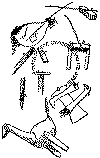By Dan Beard
" Gander-Pulling" and "The Goose Hangs High"

Fig. 362.
A Gander-Pulling Contest
When the stern Indian-fighters of the "Dark and Bloody Ground" of Kentucky and the other old frontiersmen sought relaxation in athletic sports, their games were naturally somewhat rough, but, considering the lives they were forced to lead, we cannot justly accuse them of intentional cruelty when they yanked the soft-soaped neck of a live gander in boisterous competition to see which of them was skilful enough to pull the poor goose from the perch.
But you boys of to-day can have the same fun without the slightest cruelty to any living creature, and at the same time preserve the historic and truly American sports. We must have a dummy goose as a substitute for the live one. Figs. 362 and 363 show patterns and details of a goose for this purpose.
How to Make the Goose

Fig 363.
The Gander and Details of His Make-Up
To give the bird a life-like appearance, make a neck. bone of a piece of rattan, as shown by A B C (Fig. 363); fasten one end of this to the middle of a brick-shaped block of wood with some tacks, small brads, or staple-tacks, as in the diagrams. Make the body of a bag of denim or some other strong material. Cut the pattern after that shown by C (Fig. 363), in two pieces, and stitch it down the back with strong waxed thread far enough to hold its shape, while the rattan neck and wooden-block hip-bone (J B C, Fig. 363) are inserted and held in place with the excelsior stuffing and the shoulders are stitched together. Before sewing the whole body together stuff it well with excelsior.
The material for the neck must be as strong as that used for the body, and of a substance that may be made very slippery by smearing it with a copious supply of Vaseline or any other similar stuff which will not become too hard when exposed to the cold.
Some sort of pliable leather is best adapted for the goose's neck. From this cut a pattern of the shape shown by D (Fig. 363). Fold the material in the center as at E (Fig. 363), stitch it with shoemaker's waxed-ends, as in the diagram, turn it inside out as you would a stocking, so that the seam will be on the inside, and you have the neck of the goose completed.
But to make it more natural as well as more comical the eyes and the beak should be painted, as they are in Figs 362 and 363. Fill the neck with excelsior loosely enough to allow the insertion of the neck-bone, then slip it over the bone and double-stitch the lower edge to the shoulders with strong, waxed linen thread. It is most important that 'the goose be made tough and strong. The leather cover of a foot-ball makes an excellent body for the goose.
His Wooden Legs
For the legs, cut two pieces of pine wood of the form shown by the dotted lines at B (Fig. 363) and full lines in Fig. 362, and nail them (with two small nails to each leg) to the hip-bone (C, Fig. 363), as shown by the dotted lines at B (Fig. 363). The Daniel Boone gander will then be ready for the perch G upon the gander post J (Fig. 363), where he should stand, as shown in Fig. 362.
The Gander Post
For the gander post use any sort of timber of about the thickness of a fence-post and long enough so that when the pointed end (K) is driven into the bottom of the pond the other end will protrude above the ice just high enough to place the gander within reach of the uplifted arm of the player (Fig. 362). Bore a small hole in the top of the post so that a round spike may be driven in without splitting the wood. H shows the top, K shows the bottom, and G the gander-post spike and perch fastened to the post.
You can see by Fig. 362 that the perch itself is simply a block of wood with a hole through its center so that it may revolve freely on the spike as upon a pivot.
To erect the gander post, cut a hole through the ice just large enough to admit forcing the post through it, then drive the pointed end of the post into the bottom far enough to make the post stand firmly and erect (Fig. 362).

Fig. 364.
Rah! Rah! Rah! Victory!
Now take the goose and fasten its legs to the revolving perch in such a manner that it will require a good, smart tug to tear it loose. After the neck is plentifully smeared with Vaseline you are ready for the game.
"Gander-Pulling"
consists in pulling the bird loose from its stand by grasping the slippery goose-neck while skating at full speed. If the bird is properly made and adjusted there will be lots of excitement, no end of fun, and many laugh- able failures before the winner succeeds in triumphantly snatching the slippery-necked bird from its perch, as in Fig. 364. Of course you may vary the contest by having the competitors start singly for record time; and it will therefore be necessary to have a hammer, tacks, and a plentiful supply of extra legs to keep the goose in working order. The gander post may be erected on land and the players ride horseback as did the old pioneers.
The next game is called "The Goose Hangs High," because to make a goal the player must have the goose in the crotch of the gander stick. This game is also played with a canvas or leather goose, and by players on skates or horseback.